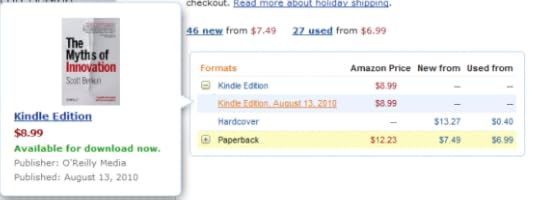Scott Berkun's Blog, page 62
December 7, 2011
Do crazy innovations affect serious subjects?
Kestutis Gardziulis, one of my kickstarter supporters for Mindfire, asked this question:
How do "crazy" innovations affect serious subjects?
Often crazy ideas in innovation history are described as accidental inventions. Things like how Nutrisweet was discovered when a chemist accidentally licked his fingers, or that Post-It notes were invented out of bad glue. These stories are told as if it were all an accident that could happen to anyone. Most people find stories told this way charming, which is why they're so popular.
The better way to consider these stories (for anyone serious about creativity) is the people involved were a) paying attention b) working hard.
Any idea, no mater how crazy, silly, or 'bad', can be reused in surprising ways, provided a and b are true.
In the cases of both Nutrisweet and Post-It notes, the inventors were not slackers. The only reason they had a chance to make these 'accidental' discoveries is that they were in a place of work, and were working. They were not on a beach reading Stephen King novels, nor in their parent's basement playing XBOX all day (although I do admit, it is also possible to discover ideas in these activities too). The 'accident' happened while they were working.
But the most profound thing is that when something crazy happened, they paid attention. They didn't throw the idea away as most of us would. Instead that asked: "this is weird… how does it work? and what might it be good for?" And set about working hard to find out what the weird or crazy accidental idea might be used for in the world, in some cases, abandoning the initial project that led to the discovery of the crazy thing in the first place.
In another way, crazy ideas that are invented as jokes or as playthings, can also become serious. Silly inventions like Hoola Hoops are now a form of exercise. A similar story is true about the poles used in adult strip clubs. Take a crazy idea from one domain, and bring it into another, and it may become something very serious indeed.
Creativity can simply be seeing a new way to use an old thing, or having the insight and courage to borrow an idea from one domain, or designed for one purpose, and apply it to another.
What stories do you know of, of an idea from one field being reused in another? Please share in the comments.
Related posts:Why you get ideas in the shower
How do you invent vaccines? An interview
All ideas are made of other ideas
Why you should be weird
Don't be precious
When is it time to quit a job to follow a dream?
Andrew Rosen of Jobacle, one of my kickstarter supporters for Mindfire, had this request for a blog post:
How do you know it is time to quit your job and put yourself into a project you believe in on a full-time basis (head and heart)?
I try to live life backwards. It's a cliché, but many cliché's are cliché's because they have some truth in them. I do periodically imagine myself on my deathbed looking back. What do I want to see?
When I do that, answers to questions like this are easy. The time is now.
Many people spend their entire lives with a dream they keep in their back pocket, expecting there to be a day with no distractions or conflicting priorities. In that fantasy, there is a day that will come, on its own, when following a dream will be the easiest choice in the world to make, and everyone, and everything in the universe will point towards the dream. That day never happens. That day has probably never happened for anyone. You have to make that day happen for yourself, often in spite of some reasonable advice to the contrary.
Most people reading this post live comfortable lives. No matter what choice you make, you will live a reasonably comfortable life, historically speaking. Review Maslow's hierarchy of needs – no matter what you do, you'll likely be ok. You have the power to take a big risk or two over the course of a lifetime and survive, or possibly thrive. But never taking a chance? Never making sacrifices to find out what's behind that dream or what's on the other side of that fantasy? Over the long view of a lifetime, that approach makes little sense.
If you want specific plans for how to quit, see: Should I quit my job now.
Related posts:How I found my passion
Should I quit my job now?
Lessons from 4 independent years
Post #1000: A Strawman for Everything
Your quota of worry and how to shrink it
Can you thrive on a sinking ship?
Josh, one of my kickstarter supporters for my Mindfire: Big Ideas for Curious Minds, asked this question.
My place of employment is closing. The problem is the mood is very somber and depressing. How do you work within that environment and not let it bring you down?
If you stand back, way, way back, the entire solar system is a sinking ship. We know the sun has just a few billion years left, and if we're still stuck on planet earth, we'll go up in flames with the rest.
Meanwhile, can we thrive here? Of course we can.
Whenever I hear of a group in trouble, or a project not going well, I think of the earth and the sun. If you frame a problem right, you can thrive anywhere. Even Sisyphus himself, according to Camus, had moments of joy here and there. I admit you can't always thrive in terms of productivity, but you can thrive in spirit.
First, its when times are tough that leaders earn their pay. It's easy to lead when everything goes perfectly. In some cases, a leader might be doing nothing at all, and ride on the waves of producvtity driven by the people who work for them. But when things go wrong, or there's bad news, or the sun starts exploding, that's when a leader earns their pay.
What goals can be set that people find interesting? What skills can people learn before the project is over? What sources of pride can be cultivated and directed at the remaining work? There are always ways to make the boring interesting, and the dull fun. It just requires someone who has authority to choose to use that authority to motivate and inspire.
I'm not suggesting denial. Everyone will process the end of a project or a company in their own way, on their own time. But for those who can find ways to stay motivated and excited about what they're doing, they should be supported and encouraged to find ways to involve others.
Lets say there are 100 people on a project that's ending. Everyone will be somber when it's announced. But the following week, what if there are 5 people, working together, having fun, and being productive. The other 95 will start to notice, and many of them will want to join the 5, in spirit, if not in work. Not everyone will be capable of coming along, but you'd be surprised. If a key leader or two take up with the minority group, it can soon become much larger than people think.
At the end of the day we all face situations we can't win and can't control. The question then becomes: how will choose to face those situations? Like Sisyphus, choosing how to respond to what we can't control might just be the most important and defining decision we ever make.
Related posts:Are you a leader or a tracker?
How to stop overcommunication
Innovation by firing people
How ideas escape their prisons
This week: winning at schedule chicken
Today is Mindfire day: Details for how to help
To help spread word of the new book, I'm asking everyone I know to tweet, post or facebook about Mindfire.
The goal is to see how high we can get the amazon.com ranking to go. Its been hovering at around #11,000 since launch. Can we get it to 7000? 2000? Lets find out.
I'll be tracking who helps (make sure to reference @berkun, www.scottberkun.com, or my name on Facebook), and giving away prizes like amazon.com gift certificates and signed copies of books.
To participate is easy. Do any of the following RIGHT NOW:
1. Tweet about Mindfire. Here's a sample tweet you can use: "Great book – Mindfire: Big Ideas for Curious Minds - fast, fun & provocative read on big ideas by @berkun http://amzn.to/mindfires #mindfire"
2. Post on Facebook. "Great new book Mindfire: Big Ideas for Curious Minds, a fast, fun and provocative read on how you think, work and dream. A great gift for creatives, leaders and thinkers – http://amzn.to/mindfires". (Tag me at Scott Berkun so I'll see it).
3. Post on your blog. You can reuse the samples above, and also mention the free preview of the book, which can be found here: http://bit.ly/mindfirepreview. Make sure to have a link to www.scottberkun.com so I can track it.
4. Buy Mindfire as a gift, or for your team. Any sales today would help enormously. If you can think of friends or co-workers who need a good read, it's a win-win: http://amzn.to/mindfires. (Also, you can gift the kindle edition of the book – it's on the same page). You can simply tweet, FB or blog about the fact that you the bought the book.
5. See who else you can get to do any of the above.
Cheers for all the help!
In return, I have a stack of new posts I've been saving up, and you'll see me posting and tweeting about them today.
Related posts:Mindfire day Dec 7th: can you help?
Buy an hour of my time, dirt cheap (and support Mindfire)
How do you get wise? The story of Mindfire
Last chance to pre-order Mindfire (my 4th book)
Mindfire preorders now up – via kickstarter
December 6, 2011
Usability issue for Kindle on Amazon.com
Noticed a small usability issue with how Amazon.com promotes Kindle editions of print books.
This is what's known as a bad default – it often happens when there are multiple defaults that could be considered logically correct, but only one is going to be considered correct by most users.
The scenario: while there is a separate URL For kindle editions of books, most often it seems people are sent to the print edition page, which shows the list of formats in a nice box in the middle of the page.
As you can see in the image below, the kindle edition listed is old. It's for the first edition of the book. You'd only notice this if you hovered over the kindle edition link long enough to see the old cover and pub date, which people in a rush to purchase are unlikely to do.
To find the latest kindle edition, you have to click on the little + icon to the left, and then click on the newer edition listed below. Surprise! The best, most awesome edition of the book is hidden down below.
The solution:
Change the default. As a rule, always default to the most recent edition of the book. For anyone who wants the first edition for some reason, they can dig in to find it. For everyone else, default to the most recent.
Related posts:My books are now on Kindle
Mindfire: Free preview now available
Usability review: parkingfriend.com
The Kindle's place in Innovation history
The motherlode of book writing statistics
Confessions of a self published author
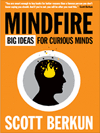 Lisa James McKenzie, one of my kickstarter supporters, requested a behind the scenes summation of my experience self-publishing my new book, Mindfire: Big Ideas for Curious Minds, a book of advice on thinking, wisdom and living a creative life.
Lisa James McKenzie, one of my kickstarter supporters, requested a behind the scenes summation of my experience self-publishing my new book, Mindfire: Big Ideas for Curious Minds, a book of advice on thinking, wisdom and living a creative life.
Here are all the questions I've been asked, with honest answers:
Why did you do this? You've had 3 bestselling books the traditional way. I know I will be writing books the rest of my life. The sooner I learn everything about the process, the better off I will be. I already know how to write – it was time to learn how to publish. Learning was my primary motivation. Even if this book doesn't sell a copy, but I learn things that help my future writing career, it was worth it. (Longer answer here). I'm friends with everyone I've worked with at O'Reilly Media. There are no hard feelings there.
What was awesome about the process? Control. The cover, title and content for any published book involves rounds of discussions between the author and the publisher, assuming you can find a publisher that is interested in the book at all. If you self-publish, you, the author, are in control. I got exactly as much input from others as I found useful. I used my blog to get feedback from my readers on the title, on the cover, and the book itself, but I had complete control over that process.
What sucked about the process? Control :) If you have control over everything, you have to take care of everything. Every single task must be done by you, or you must hire someone to do it.
What was unexpected? It was easy. If you can make a PDF, and hire a good designer, you can print a professional looking book. The hard part, as always, is writing the book itself. If you can write a book, you can self-publish a book.
How did you hire people? I used scottberkun.com to find a designer and an editor/curator, by asking people to apply. I wanted to find someone already interested in my work. The response was amazing (~40 people applied for each role). I picked 3 people for each role and paid them to do a trial task. Based on the results, I hired Tim Kordik (cover and interior design) and Krista Stevens (editor). The always amazing Marlowe Shaeffer took over the editorial reigns for the last leg of the project and helped drive it home.
What were the costs? If you use a Print On Demand printer, costs are low. You'll need to hire a designer and editor, but otherwise the base costs are a few hundred dollars. You pay a fee to setup an account with the printer, the e-book service and for an ISBN number. You also need to have an LLC to work with some printers. PR and marketing are likely the largest costs you will have, but how much you spend is up to you.
What services did you use? Based on research, and advice from author Phil Simon, I used Lightningsource, a Print on Demand service (POD). POD means there is no inventory – they print books as they are ordered (which happens so fast, no customer on amazon.com would ever know). They also take care of listing the book on Amazon.com. I used bookbaby.com for all the e-books: they take an epub file, and convert and deliver the book to kindle, iBookstore, B&N and Sony Reader.
What was a pain in the neck? Some of these services are not designed for consumers, so their websites suck and take time to learn. The worst offenders are Lightningsource and Bowker.com (the service used to buy ISBN numbers). Once learned, most processes are easy. The other major issue is timing – these services do not guarantee specific dates, so launching a book is hard to time PR-wise. The other challenge with POD is there are no pre-orders. I used kickstarter to help solve that problem.
What would you do differently? Not much. I'm not sure the next book will be self-published, but I'd definitely consider doing it again.
Want to see the results? The free preview is here – Mindfire Preview (PDF) – its nearly 1/3rd of the book, all for free. Take a look – let me know what you think. So far the book is doing well with nearly 30 reviews.
If you found this post useful, please consider buying the book.
What questions do you have? Leave them in the comments. I'm happy to answer.
Related posts:Help wanted: Editor/Curator for my next book
The age of the platform: lessons on self-publishing from 4 time author
Help Wanted: Designer for my next book
Help wanted: designer for next book (updated)
Why do essay collection books suck?
December 5, 2011
Quote of the week
"A lot of my job is taking what they bring and turning it into something. This is a chord change, this is this, this a melody, ok – but what does that mean? Where am I? If I close my eyes, where am I? What does this music mean?"
– Eddie Vetter, about Pearl Jam (From Pearl Jam 20)
Related posts:Quote of the month
Quote of the week
Quote of the week
Death by Christmas Music
This week in ux-clinic: harvesting the idea farm
November 30, 2011
How to understand the media (Review of The Influencing Machine)
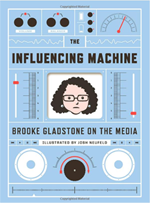 We often talk about "the media" as if it were as singular monolithic thing, which it isn't. There are many forces working independently of each other. When combined we experience them all as a unified thing, but it isn't truly singular nor unified in any way. Any argument about media that includes the phrase "the media" should be stopped. It's conveniently assuming something about the world that isn't true.
We often talk about "the media" as if it were as singular monolithic thing, which it isn't. There are many forces working independently of each other. When combined we experience them all as a unified thing, but it isn't truly singular nor unified in any way. Any argument about media that includes the phrase "the media" should be stopped. It's conveniently assuming something about the world that isn't true.
This bias we have towards constructing easy targets to argue about is one of our greatest problems with understanding media. When you stop and avoid saying "the media is…" you're forced to think more carefully about what you're really upset about and what the real causes are.
If you want to get past your pet biases and better understand how media works, the book The Influencing Machine, by Brook Gladstone (of NPR) is a good place to start.
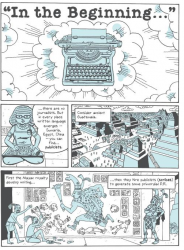 It's a graphic book, illustrated well by Josh Neufeld, which means it's a combination of comic like panels, mixed with short essays. I like this style of book when it's done well (this one is), but it's not for everyone.
It's a graphic book, illustrated well by Josh Neufeld, which means it's a combination of comic like panels, mixed with short essays. I like this style of book when it's done well (this one is), but it's not for everyone.
The strengths of the book are its telling of (U.S.) media history. It explores the problematic origins of journalism, how the early press in the U.S. developed (which is shockingly familiar to many who complain about modern journalism), and the inherent good and bad challenges it has wrought throughout our history. Some stories I knew, but others were launching points to research online. Brookstone takes the position that we are a large part of our sense of "media", as we make choices about what we read, how we read it and the questions we choose to ask or not. She also explores the challenge of objectivity, and challenges the notions most people assume about the objectivity of what the read and hear.
The weaknesses of the book are twofold. First, if you've studied media theory and cognitive bias, you'll be on familiar turf. Second, the last quarter of book switches into future thinking, and here Brookstone is on weaker ground. The book is stronger in its telling of history and Brookstone's insightful view of how media has functioned, rather than her looking to the future. It'd also be easy to criticize the book for a having a mild liberal tilt, as some negative examples come at the expense of (in)famous Republicans/Conservatives.
The book lightly touches on social media's impact, which is fine. But it is notable Brooke doesn't appear to have a twitter account (I couldn't find it). However Josh Neufeld does.
It's a fast read as most good graphic books are, and will definitely improve how you think about media in all its forms.
Related posts:Crap detection 101 and social media
Wednesday linkfest
ArtofPM on Business Week
Calling bullshit on social media
Help wanted: Editor/Curator for my next book
Mindfire day Dec 7th: can you help?
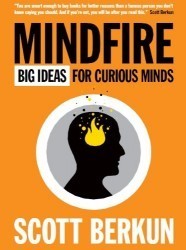 Behind the scenes I've been working hard to generate PR for Mindfire: Big Ideas for Curious Minds. We're up to nearly 25 amazon.com reviews (thanks!) and lifehacker posted an excerpt. But as a self-published book, I need all the support I can find.
Behind the scenes I've been working hard to generate PR for Mindfire: Big Ideas for Curious Minds. We're up to nearly 25 amazon.com reviews (thanks!) and lifehacker posted an excerpt. But as a self-published book, I need all the support I can find.
The groundwork is set and I've done what I can on my own: it's time to ask for help.
On Wed Dec 7th, we're going to see how high we can get the amazon.com ranking for the book to go. We'll aim at 12pm PST, but any time during the day helps.
Each sale on the day contributes to lowering the ranking. Its been hovering around #13,000 for the last week. Can we break 8000? 2000? 1000?
If you have 60 seconds to help, here's what you can do:
Leave a comment saying "I'll help – Go Mindfire!" or something similiarly silly. By leaving a comment I can follow up with you via email to help organize. It will be very simple, I promise.
Mark your calendar for Wed Dec 7th. And plan to tweet, facebook, blog, or dance suggestively in public (if that's your thing) about the book. (Click here to add a reminder to your calendar).
Plan to buy the book as a holiday gift, or for your team, on Wed Dec 7th.
I'll provide more details, including sample tweets, facebook and blog posts you can reuse if you like.
If you want to sample the goods before you'd help with something like this, your wish is my command: Preview of Mindfire (PDF).
Thanks for your help and support. I hope you'll leave a comment.
Related posts:Mark the Date: Oct 13th Myths of Innovation day
Countdown begins: Mindfire book launch in 6 days
Mindfire: Free preview now available
Need ideas: fun rewards for Mindfire book pre-orders?
Winners of 5 signed copies are…
The Symbolic Violence of Twitter
 One of my kickstarter supporters for Mindfire is a blogger and speaker in his own right: Luca Sartoni. He wrote a provocative article I read months ago about the dangerous implications of using follower counts as status, called Symbolic Violence and Social Media.
One of my kickstarter supporters for Mindfire is a blogger and speaker in his own right: Luca Sartoni. He wrote a provocative article I read months ago about the dangerous implications of using follower counts as status, called Symbolic Violence and Social Media.
He points out how the application of a basic idea from Bourdieu suggests social mediums, which exagerate the value of symbolic capital, can be dangerous to culture:
He [Bourdieu] extended Marxist theory about capital, whereby people's capital is split into four kinds: Economic, Social, Cultural and Symbolic.
Economic Capital is very easy to explain: money, time and production tools.
Social Capital is the number of people we know; our social circle.
Cultural Capital is what we know; our education and culture.
Symbolic Capital is the set of symbols recognized and legitimated by other people: job titles, study degrees, uniforms.
For example, having $20k is economic capital. Having studied money for 20k hours is cultural capital. But having 20k followers on twitter may just be symbolic capital. Some of it may be social capital, but its a kind that is easier to earn than non-virtual social capital, and its also a kind of capital we flaunt in front of others, questioning our motivations for getting it in the first place.
I recommend you read the full article – its sure to get you thinking: Symbolic violence and Social Media.
Related posts:How to call BS on a social media guru (event)
Twitter vs. Deep reading?
Twitter reconsidered
Lessons on social bookmarking (Learning from del.ico.us & blink)
Good, evil and technology: a fun philosophical inquiry


